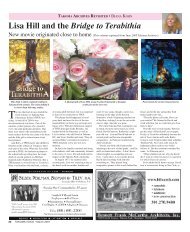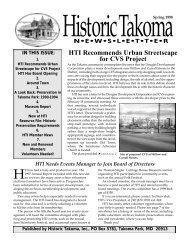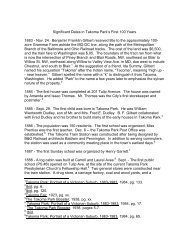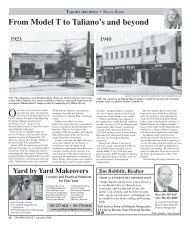The nostalgic murals of Takoma Junction - Historic Takoma Inc.
The nostalgic murals of Takoma Junction - Historic Takoma Inc.
The nostalgic murals of Takoma Junction - Historic Takoma Inc.
You also want an ePaper? Increase the reach of your titles
YUMPU automatically turns print PDFs into web optimized ePapers that Google loves.
Ta k o m a Ar c h i v e s • Di a n a Ko h n<br />
<strong>The</strong> <strong>nostalgic</strong> <strong>murals</strong> <strong>of</strong> <strong>Takoma</strong> <strong>Junction</strong><br />
<strong>The</strong> most prominent landmarks at<br />
<strong>Takoma</strong> <strong>Junction</strong> these days are the<br />
large <strong>murals</strong> that adorn the three<br />
buildings facing the intersection.<br />
Other landmarks are long gone: General<br />
Carroll’s manor house. which dominated<br />
the corner for nearly a 100 years, was<br />
demolished in 1960 after years <strong>of</strong> neglect.<br />
<strong>The</strong> trolley line stopped running years<br />
before that.<br />
And the fire station at the outside edge<br />
<strong>of</strong> the <strong>Junction</strong> awaits a long-delayed<br />
knockdown-and-replacement, which will<br />
erase its familiar stone facade from the<br />
streetscape.<br />
<strong>The</strong> storefronts remain much as they<br />
have always been since the early 1930s -<br />
small businesses modestly providing local<br />
residents with groceries, haircuts, electrical<br />
repairs, drycleaning, even picture framing.<br />
But thanks to these <strong>murals</strong> the corner has a<br />
distinctive character.<br />
That was the intent. In 1984, the<br />
neighborhood was struggling with the<br />
departure <strong>of</strong> Barcelona Nuts, the largest<br />
industrial establishment in the city.<br />
Ed McMahon served on the committee<br />
that launched the revitalization effort. One<br />
tactic was christening the intersection as<br />
<strong>Takoma</strong> <strong>Junction</strong>.<br />
McMahon was also chair <strong>of</strong> the Public<br />
Arts Committee, and he suggested a<br />
second tactic: creating what he called a<br />
photo: Julie Wiatt<br />
Sandra Philpott’s Victorian image <strong>of</strong> <strong>Takoma</strong> Park has graced <strong>Takoma</strong> <strong>Junction</strong><br />
since 1985. <strong>The</strong> accompanying portraits (below) have since been painted over.<br />
“placemaker,” outdoor public art which<br />
could help define and reinforce the identity<br />
<strong>of</strong> the area.<br />
He had already had success with<br />
<strong>murals</strong> in Old <strong>Takoma</strong> and urged a similar<br />
approach in the needed revival at the<br />
<strong>Junction</strong>.<br />
<strong>The</strong>re was a perfect canvas in the brick<br />
wall <strong>of</strong> the storefront at the corner <strong>of</strong><br />
Sherman and Carroll. Sandra Philpott, a<br />
local artist who had participated in the Old<br />
Town <strong>murals</strong>, <strong>of</strong>fered a <strong>nostalgic</strong> collage<br />
evoking <strong>Takoma</strong>’s Victorian past and the<br />
committee gave the go-ahead.<br />
Phillpott gathered elements from historic<br />
photos to create a unique image. <strong>The</strong><br />
policeman is Sgt. John Barry, the crossing<br />
guard at the railroad in the days before the<br />
underpass. Honoring the trolley cars that<br />
passed through the <strong>Junction</strong>, she portrayed<br />
the beloved “Dinky line” on its way to<br />
Sligo Creek. Children and flags and dogs<br />
aspoke <strong>of</strong> the bucolic childhood possible in<br />
this railroad suburb six miles from DC.<br />
<strong>The</strong>n there was the enigmatic elephant,<br />
seemingly added from her imagination.<br />
Folks like Roland Dawes in his barber<br />
shop half a block away vividly remember<br />
the carnivals that brought the elephants to<br />
town in his childhood. “<strong>The</strong>y came twice a<br />
year and set up a Ferris Wheel in the vacant<br />
lot on the corner. <strong>The</strong>re were games <strong>of</strong><br />
chance, and the elephants.”<br />
In addition to the 14 ft by 16 ft mural,<br />
Philpott created a set <strong>of</strong> five “trompe<br />
l’oeil” family portraits tucked into each<br />
<strong>of</strong> the boarded-up windows on the side <strong>of</strong><br />
the building. <strong>The</strong>y represented the diverse<br />
set <strong>of</strong> personalities important to <strong>Takoma</strong><br />
history, including:<br />
• B.F. Gilbert (the visionary behind<br />
<strong>Takoma</strong> Park),<br />
• Pamela Favorite (early storekeeper),<br />
• Lee Jordan (founder <strong>of</strong> the Boys and<br />
Girls Club),<br />
• Goldie Hawn (actress),<br />
• Anna Maria Ariaza <strong>of</strong> Guatamela and<br />
12 TAKOMA VOICE • June 2008
Jim Colwell’s “Guardians <strong>of</strong> the Neighborhood” has been a popular addition to <strong>Takoma</strong> <strong>Junction</strong>.<br />
photo courtesy <strong>of</strong> Jim colwell<br />
Ty Eam <strong>of</strong> Cambodia (recent arrivals who<br />
represent <strong>Takoma</strong> Park’s ethnic heritage<br />
and diversity).<br />
In the years since Philpott finished her<br />
work and moved to Harrisburg, High’s<br />
Convenience Store has given way to TJ’s<br />
Market but the mural remains, albeit<br />
somewhat worse for wear.<br />
It turns out that Sandra used ordinary<br />
house paint and applied it directly to the<br />
bricks. Even a recent touchup several years<br />
back failed to halt the deterioration.<br />
<strong>The</strong> portraits faded more quickly than<br />
the larger mural and were eventually<br />
painted over with other images. Luckily,<br />
a plaque commemorating their names<br />
remains on the wall near the mural.<br />
<strong>The</strong> carnivals halted once Shell built a<br />
gas station on the empty lot (perhaps 1940)<br />
and there was no longer any place to set up.<br />
Ironically, that gas station became the<br />
next canvas. Abandoned sometime in the<br />
Sixties it was briefly resurrected as the<br />
“Sister Cities Thrift Store.”<br />
For more than a decade, <strong>Takoma</strong> Park<br />
enjoyed a rich cultural exchange with its<br />
Sister City <strong>of</strong> Jequie, Brazil. Students from<br />
each town tregularly switched places. <strong>The</strong><br />
thrift store was a needed source <strong>of</strong> funds.<br />
By 1990, however, the cement<br />
block building was vacant again. <strong>The</strong><br />
Revitalization Committee seized the<br />
opportunity to create a pocket park on the<br />
corner dedicated to B.Y. Morrison, the<br />
genius behind azaleas.<br />
McMahon remembered using open<br />
space money to fund the project. Public art<br />
once again became part <strong>of</strong> the package.<br />
A new call for projects went out<br />
nationwide, and more than 100 proposals<br />
were received. But one local artist -- Jim<br />
Colwell, a piano restorer by trade -- had a<br />
winning idea.<br />
McMahon recalls that Colwell’s jazz<br />
combo, reflecting the diversity he saw in<br />
<strong>Takoma</strong> Park, was the hands-down favorite<br />
<strong>of</strong> the Arts Committee.<br />
Jim remembers “<strong>The</strong>re was some<br />
controversy with the design. I originally<br />
had an old man playing the guitar on<br />
the left, but I was asked to substitute a<br />
Latina. And the central figure was dressed<br />
in a lower-cut dress than you see today.<br />
Even with the alterations some folks took<br />
umbrage.<br />
“When I was installing the finished<br />
mural, the owner <strong>of</strong> Turner Electric would<br />
come over every day to rail about how<br />
much he hated it. I just keep saying I was<br />
the hired help.”<br />
Today the exotic caricatures in hte<br />
mural, known <strong>of</strong>ficially as Guardians <strong>of</strong><br />
the Neighborhood,” define the <strong>Junction</strong><br />
as much as the Victorian mural across the<br />
street.<br />
In an effort to ensure the survival<br />
<strong>of</strong> “Guardians,” the city has slated the<br />
building for ro<strong>of</strong> repair and replacement <strong>of</strong><br />
the tiles on the pillars.<br />
Thanks to a grant from the reconstituted<br />
<strong>Takoma</strong> Park Arts and Humanities<br />
Commission, John Hume <strong>of</strong> Sligo Tile<br />
Co. will replace the tiles with decorative<br />
tiles. Designed to reflect “Tales <strong>of</strong> Mystery<br />
and Wonder.” the new tiles will depict<br />
Motorcat, Roscoe the Rooster and the<br />
elephant <strong>of</strong> carnival fame among other<br />
fanciful images.<br />
<strong>The</strong> most recent mural is the largest,<br />
covering the side wall <strong>of</strong> the <strong>Takoma</strong> Park-<br />
Silver Spring Co-op. A new arrival at the<br />
<strong>Junction</strong>, the Co-op took over the Truner<br />
Electric building (which once housed a<br />
Safeway) in 1998.<br />
In 2003, the large blank expanse <strong>of</strong> brick<br />
inspired Co-op enployee Aslia Schwartz to<br />
envision a quirky tree motif to help identify<br />
the store.<br />
Look carefully at the artwork and you<br />
will see how she created a mosaic effect<br />
by painting each brick a different shade <strong>of</strong><br />
brown.<br />
Collectively the three <strong>murals</strong> have not<br />
solved the underlying problem <strong>of</strong> how to<br />
revive the <strong>Junction</strong>, but they have enhanced<br />
the historic context and identity. even as the<br />
debate continues about the possible future<br />
scenarios for <strong>Takoma</strong> <strong>Junction</strong>. More about<br />
that debate next month.<br />
Diana Kohn is Education Chair <strong>of</strong><br />
<strong>Historic</strong> <strong>Takoma</strong>.<br />
Deadline extended for <strong>Takoma</strong> Park Folk<br />
Festival T-Shirt Design Contest<br />
<strong>The</strong> Elephant<br />
<strong>The</strong> deadline for the <strong>Takoma</strong> Park<br />
Folk Festival T-Shirt Design Contest<br />
has been extended until June 20, the<br />
organizers announced last week. “Due<br />
to a problem with the Festival’s website,<br />
some people have been unable to access<br />
the contest’s rules and entry form,” said<br />
Kevin Adler, Festival chair. “We want<br />
to encourage as much participation<br />
as possible, so we feel that it’s fair to<br />
extend the deadline for two weeks.”<br />
<strong>The</strong> winning entry for the Festival<br />
will be used for t-shirts sold at this<br />
year’s Festival, and the artist will receive<br />
$200. Designs should reflect the music,<br />
dance and cultural heritage displayed<br />
at the Folk Festival. A panel will judge<br />
the entries on originality, artistic merit,<br />
suitability for reproduction on a shirt,<br />
and reflection <strong>of</strong> the themes <strong>of</strong> the<br />
Festival. Full instructions are available<br />
at www.tpff.org or by sending an email<br />
to info@tpff.org.<br />
June 2008 • TAKOMA VOICE 13














